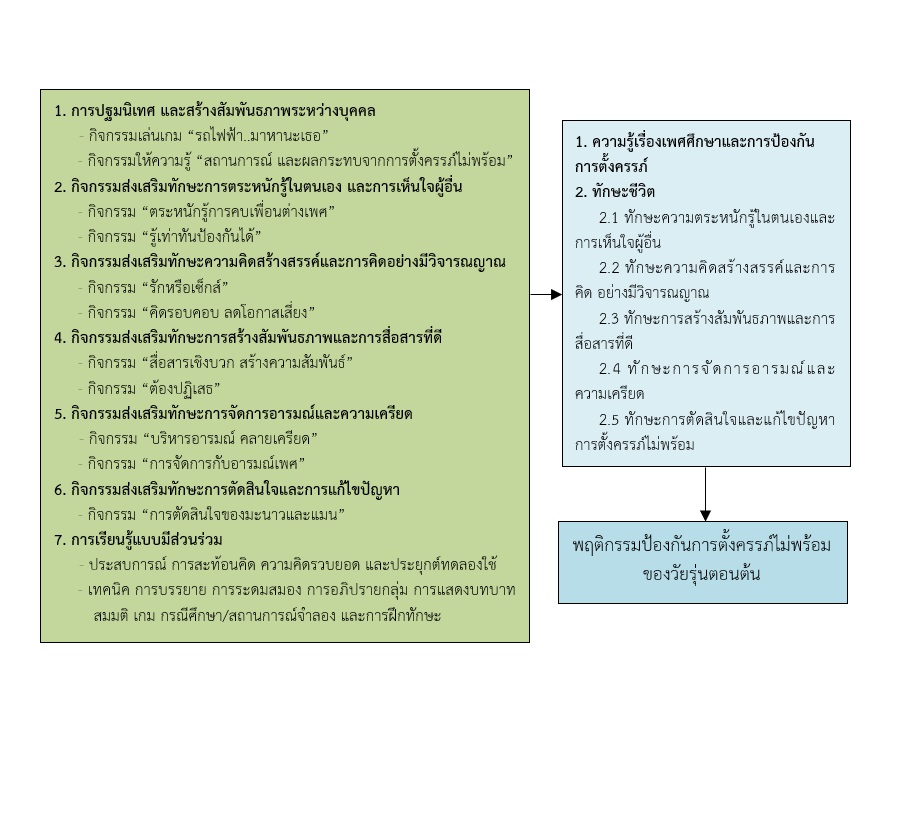ผลของโปรแกรมส่งเสริมทักษะชีวิตแบบมีส่วนร่วม ต่อความรู้เรื่องเพศศึกษา ทักษะชีวิต และพฤติกรรมป้องกันการตั้งครรภ์ไม่พร้อมในวัยรุ่นตอนต้น
คำสำคัญ:
โปรแกรมส่งเสริมทักษะชีวิตแบบมีส่วนร่วม, ความรู้เรื่องเพศศึกษา, พฤติกรรมป้องกันการตั้งครรภ์ไม่พร้อม, วัยรุ่นตอนต้นบทคัดย่อ
การวิจัยกึ่งทดลองแบบสองกลุ่ม วัดผลก่อนและหลังการทดลอง มีวัตถุประสงค์เพื่อเปรียบเทียบความรู้เรื่องเพศศึกษาและการป้องกันการตั้งครรภ์ ทักษะชีวิต และพฤติกรรมป้องกันการตั้งครรภ์ไม่พร้อมในวัยรุ่นตอนต้น ระหว่างกลุ่มที่ได้รับโปรแกรมส่งเสริมทักษะชีวิตแบบมีส่วนร่วมกับกลุ่มเปรียบเทียบก่อนและหลังการทดลอง กลุ่มตัวอย่างเป็นนักเรียนชั้นมัธยมศึกษาปีที่ 2 โดยเลือกโรงเรียนตามคุณสมบัติที่กำหนด สุ่มอย่างง่ายเลือกโรงเรียน และสุ่มนักเรียนทั้งชั้น ได้กลุ่มตัวอย่าง จำนวน ได้กลุ่มตัวอย่าง จำนวน 50 คน แบ่งเป็นกลุ่มทดลองและกลุ่มเปรียบเทียบ กลุ่มทดลอง 25 คน และกลุ่มเปรียบเทียบ 25 คน ด้วยวิธีใช้โปรแกรมสำเร็จรูป G*Power เครื่องมือการวิจัย ได้แก่ โปรแกรมส่งเสริมทักษะชีวิตแบบมีส่วนร่วมในการป้องกันการตั้งครรภ์ไม่พร้อม พัฒนาขึ้นตามแนวคิดทักษะชีวิตของกรมสุขภาพจิต ร่วมกับการเรียนรู้แบบมีส่วนร่วม มีระยะเวลา 6 สัปดาห์ และแบบสอบถาม ประกอบด้วย 3 ส่วน ได้แก่ ข้อมูลทั่วไป ความรู้เรื่องเพศศึกษา ทักษะชีวิต และพฤติกรรมป้องกันการตั้งครรภ์ไม่พร้อม มีค่าความตรงตามเนื้อหา .97, .98 และ .94 มีค่าความเที่ยงเท่ากับ .60, .90 และ .70 ตามลำดับ วิเคราะห์ข้อมูลด้วยสถิติพรรณนาและสถิติทดสอบที Paired t-test และ Independent t-test ผลการวิจัยพบว่า
ภายหลังเข้าร่วมโปรแกรมส่งเสริมทักษะชีวิตแบบมีส่วนร่วม กลุ่มทดลองมีคะแนนเฉลี่ยความรู้เรื่องเพศศึกษา ทักษะชีวิตโดยรวม และพฤติกรรมป้องกันการตั้งครรภ์ไม่พร้อมของวัยรุ่นตอนต้น (M=8.08, SD=1.15, M=319.12, SD=6.36, M=93.92, SD=3.79 ตามลำดับ) สูงกว่าก่อนเข้าร่วมโปรแกรม (M=5.80, SD=1.44, M=278.40, SD=20.49, M=77.88, SD=5.55 ตามลำดับ) และสูงกว่ากลุ่มเปรียบเทียบ (M=5.92, SD=1.07, M=292.80, SD=20.27, M=74.88, SD=5.55 ตามลำดับ) อย่างมีนัยสำคัญทางสถิติที่ระดับ .001
ควรนำโปรแกรมส่งเสริมทักษะชีวิตแบบมีส่วนร่วม ในการป้องกันการตั้งครรภ์ไม่พร้อมในวัยรุ่นตอนต้น ถ่ายทอดให้กับครูในโรงเรียน เพื่อจัดการเรียนการสอนเพศศึกษาให้กับนักเรียนต่อไป
เอกสารอ้างอิง
Bloom, B. S., Hastings, T. J., & Madaus, G. F. (1971). Hand Book on Formative and Summative Evaluation of Student Learning. New York: McGraw – Hill Book Compaany Inc.
Chiraporn, A. (2017). Safe Sex. Retrieved October 30, 2018 from https://med.mahidol.ac.th/ ramachannel/home/article/safe-sex-.
Cohen, J. (1988). Statistical Power Analysis for the Behavioral Sciences. 2nd ed. Hillsdale, New York: Lawrence. Erlbaum Associates, Publishers.
Department of Mental Health, Ministry of Public Health. (2000). Participatory Learning Training Manual. Retrieved October 30, 2017 from www.dmp.ac.th.
HDC Permanent Secretary Office of the Permanent Secretary. (2018). HDC Annual Report 2018 Retrieved June 25, 2018. http://203.157.229.18/inspec/2561/inspec1/doc22dec/.
Jetnipit, S. (2007). The Effectiveness of Life Skills Enhancement Program and Partipatory Learning on Preventive Sexual Behaviors of Junior High School Students in One High School Muang District Khonkaen Province. A Thesis Submitted in Partial Fulfilment of the Reouirements for the Degree of Master of Public Health in Health Education and Health Promotion Graduate School, Khonkaen University. (in Thai).
Lamchiek, K. (2014). How to Prevent Unwanted Teenage Pregnancy. Journal of Boromarajonani College of Nursing, Bangkok, 30(3), 97-105.
Nedsine, P. (2009). Life Skills Promoting Program to Prevent Sexual Behavior Among Female Junior High School Students in Prajuabkirikan Province. Public Health Major in Health Education and Health Behavioral Sciences, Mahidol University. (in Thai)
PATH. (2007). Guide to Learning Process of Sex Education for Youth Level 3 Secoundary 1 Through Mattayom 3. Bangkok: Urgent Tag CO.
Phataraporn, S. (2014). Life Skills Promotion with Group Process and Reinforcement for Sexual Premature Prevention among the Sixth Grade Students. A Thesis for the Degree of Master of Public Health Graduate School, Khonkaen University. (in Thai)
Prathya, S. (2015). Teenage Pregnancy. Retrieved October 30, 2018 from https://www.slideshare.net/prachayasriswang3/ppt-51936232.
Puncharas, S. (2012). Knowledge Attitude and Pregnancy Prevention Behavior of Students Secondary Education in Nakhon Chai Burin Area. Regional Health Promotion Center 5 Journal, 6(13), 8-25. (in Thai)
Tiyapon, K. (2017). Faculty of Industriol Education and Technology King Mongkut,s Institute of Technology Ladkrabong Indicating Solutions and Prevention “Sex in Teen, Fails”. Retrieved August 30, 2017 from https://siamrath.co.th/n/9522.
Unicef Thailand. (2015). To Analyze the Situation of Teenagers in Thailand 2015-2016. Retrieved October 30, 2017 from https://www.unicef.org/thailand/th/reports /%E0%B8%.
Unicef Thailand. (2017). Analysis of the Situation of Adolescents in Thailand 2015-2516. Retrieved https://www.unicef.org/thailand/th/reports/%E0%B8%
World Health Organization. (1994). Life Skills Education for Children and Adolescents in School. Geneva Switzerland.

ดาวน์โหลด
เผยแพร่แล้ว
ฉบับ
ประเภทบทความ
สัญญาอนุญาต
1. บทความหรือข้อคิดเห็นใด ๆ ที่ปรากฏในวารสารเครือข่าย วิทยาลัยพยาบาลและการสาธารณสุขภาคใต้ ที่เป็นวรรณกรรมของผู้เขียน บรรณาธิการหรือเครือข่ายวิทยาลัยพยาบาลและวิทยาลัยการสาธารณสุขภาคใต้ ไม่จำเป็นต้องเห็นด้วย
2. บทความที่ได้รับการตีพิมพ์ถือเป็นลิขสิทธิ์ของ วารสารเครือข่ายวิทยาลัยพยาบาลและการสาธารณสุขภาคใต้







